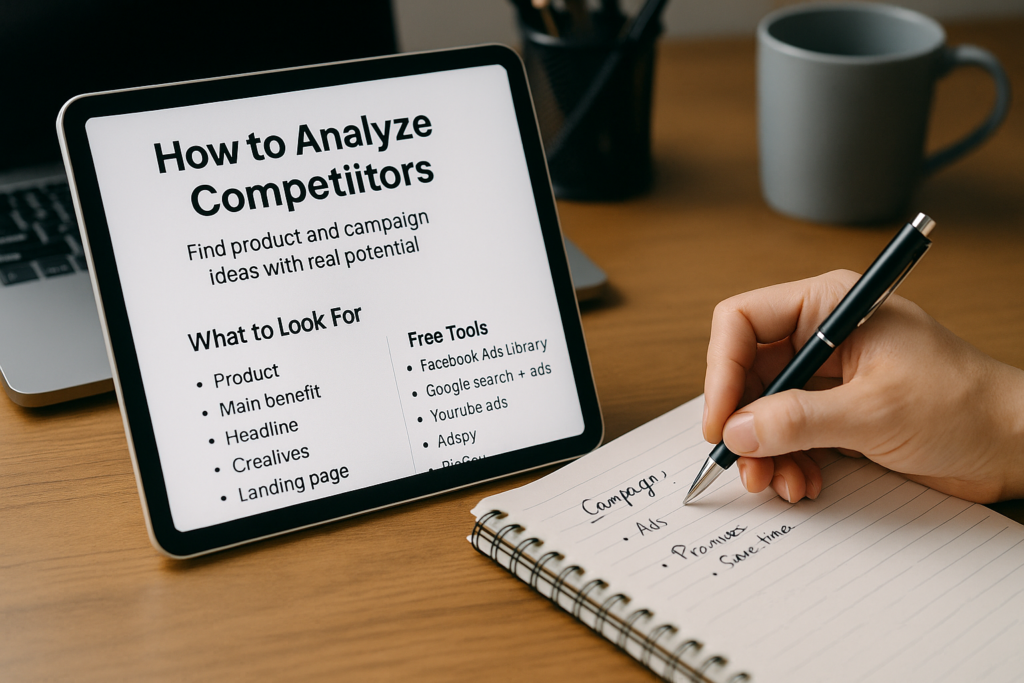Feeling stuck about what to sell, what kind of ad to create, or how to build a high-converting funnel? You’re not alone. But here’s the secret: your competitors are doing the hard work for you — and you can legally watch, learn, and adapt.
In this complete guide, you’ll discover how to ethically “spy” on your competitors, find out what’s working for them, and use those insights to create smarter campaigns, choose better products, and grow your results — even if you’re just getting started.
Let’s break it all down, step by step. 🧠
👁️🗨️ Why Competitor Analysis Is a Game-Changer

You don’t have to guess. You don’t have to start from scratch.
Smart marketers and traffic managers know that analyzing what others are doing in your niche helps you:
- 🕒 Save time on testing
- ❌ Avoid common mistakes
- 🚀 Discover trending products
- 🎨 Get inspiration for ad creatives and angles
- 🎯 Understand what works with your target audience
In short: your competitors are investing money in ads — and the ads they continue running are usually the ones that convert.
💡 Want to learn how to monetize that traffic? Read: 🤑 How to Monetize a Blog with Google AdSense (Step-by-Step for Beginners)
🧭 What to Look For in a Competitor’s Campaign
When analyzing any campaign — whether on Facebook, Google, or YouTube — here are key questions to guide your research:
1. What are they selling?
- Is it a physical product, a digital course, a service?
- Are they promoting a lead magnet first or going straight to the sale?
2. What’s the main benefit?
- What pain point or desire does the ad focus on?
- Is there a clear value proposition?
3. How is the copy written?
- Short and punchy or long-form storytelling?
- Does it use emotional triggers, urgency, curiosity?
4. What kind of creative are they using?
- Image, video, carousel?
- Do visuals show the product in use or rely on graphics?
5. What does the landing page look like?
- Is it clean and minimal, or more premium and detailed?
- Are they collecting emails or pushing direct checkout?
All these details give you real-time clues about what’s working — and what audiences respond to.
🛠️ Free Tools to Ethically Spy on Competitors
You don’t need fancy software (although some are great). Here are powerful tools — many free — to get the job done:
1. 📘 Facebook Ads Library
Search for any business page or keyword and see all active ads running on Facebook, Instagram, and Messenger.
Tips:
- Try searching for keywords like “ebook,” “online course,” or “meal plan.”
- Look for trends: Are many pages promoting the same type of offer?
2. 🔍 Google Search + Google Ads
Search like a user. Try phrases like:
- “Best course to learn digital marketing”
- “How to lose weight without dieting”
Click on the paid results (usually the first 2–3 links) and explore:
- Ad headlines
- Landing page design
- Funnel structure (do they upsell, capture leads, or redirect?)
3. ▶️ YouTube Ads
Watch for skippable or non-skippable ads before videos. These often reveal:
- High-converting scripts
- Attention-grabbing visuals
- CTAs that push to a landing page
Search for broad keywords like:
- “Make money online”
- “Start an online business”
Then take note of recurring ads — these are usually the best performers.
4. 🛠️ Bonus Tools (Optional, Advanced)
If you want to go deeper:
- BigSpy (free version available): ad inspiration across multiple platforms
- AdSpy (paid): massive searchable ad database
- SimilarWeb: check competitor website traffic sources and engagement
- Semrush: analyze paid keyword strategies and display ad performance
📂 Pro Tip: Build Your Own Swipe File
Create a Google Drive or Notion database and start collecting:
- Ad screenshots
- Landing page links
- Headline examples
- Funnel flows
This becomes your idea bank — so when it’s time to launch your own campaign, you don’t start from a blank page.
✅ Bonus resource: Want to optimize your funnels? Check out: 🧩 How to Build a Validated Funnel Structure Based on Competitor Analysis
🧪 How to Turn Research into Action
Observing is just the first step. You now need to test and implement what you find.
Step-by-step:
- Choose 3–5 top competitors in your niche
- Use Facebook Ads Library and Google to collect their current campaigns
- Study their landing pages and funnel flow
- Adapt headlines, angles, and creatives to fit your offer
- Start testing with small paid traffic campaigns (Google, Meta, etc.)
- Track what performs best — then scale
And remember: you’re not copying — you’re modeling. Learn what works, adapt ethically, and bring your own voice.
Want a list of top platforms to run your first ad? Read: 🎯 Top Advertising Platforms for Beginners in Traffic Management
💬 Want a Free Competitor Analysis Template?
If you’d like a ready-to-use Google Sheets template to organize and track your competitor research, drop a comment or send us a message! It includes:
- Columns for ad copy, creatives, traffic sources, funnel type
- Notes section to highlight what you’d improve or test
We’re building tools to help you launch smarter and faster.
📢 What’s Next?
In the next article, we’ll show you how to turn this competitor research into a complete funnel, from the first click to the conversion — without complicating the process.
Stay tuned! 👀
✅ Conclusion
Analyzing your competitors is one of the most powerful (and underrated) strategies in digital marketing. It lets you shortcut the learning curve, avoid common traps, and gain clarity on what works — all without spending a cent on guesswork.
Make it a weekly habit. Build a swipe file. Use what you find to inspire your ads, funnels, and content. That’s how real marketers grow — by learning from what’s already proven to work.
🔗 Related Posts to Explore Next:
- 🧩 How to Build a Validated Funnel Structure Based on Competitor Analysis
- 🛍️ The Best Types of Digital Products to Sell with Paid Traffic
- ✅ Complete Optimization Checklist for Paid Traffic Campaigns and Landing Pages
- 🔁 How to Build an Effective Sales Funnel Using Paid Traffic (Even If You’re Starting from Scratch)
